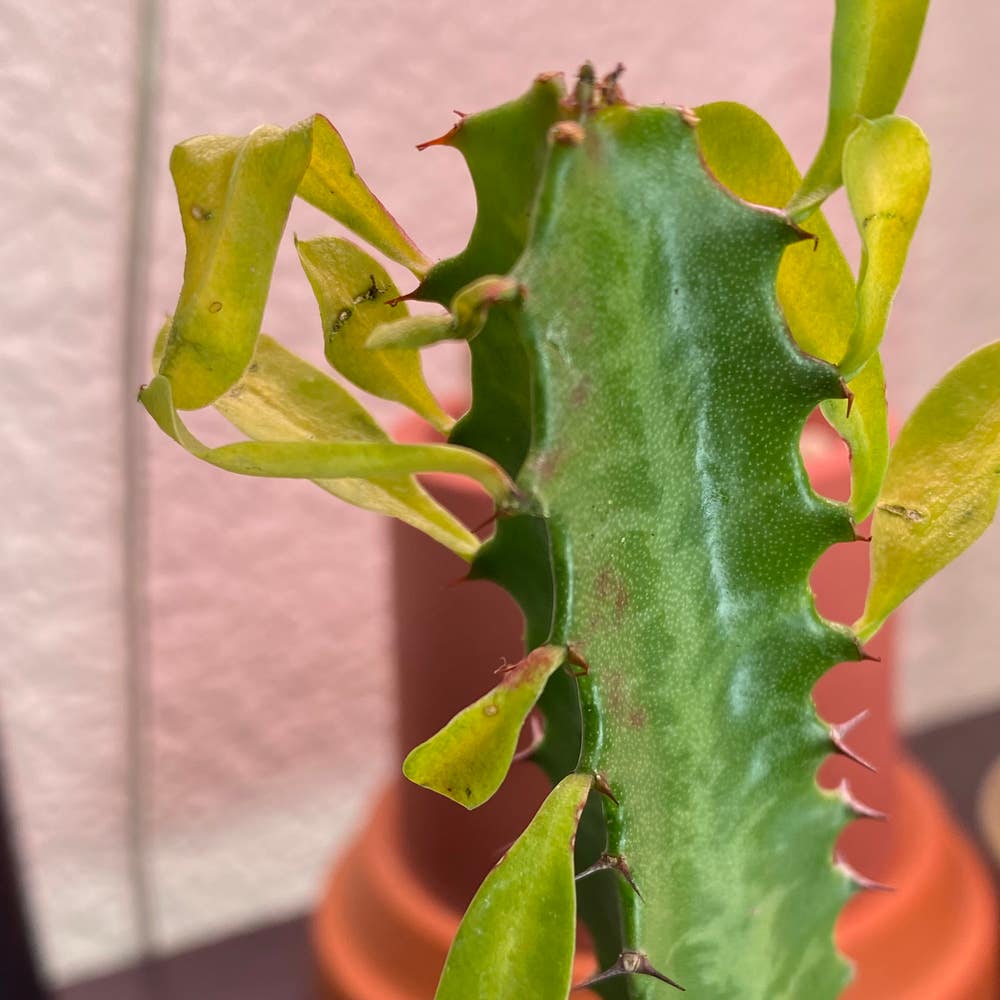What Do I Do About euphorbia adenochlora root rot?
Mar 12, 2024•5 min read
Rescue your Euphorbia adenochlora from root rot and ensure its future health with our expert guide! 🌿🚑
- Wilting and yellowing leaves signal potential root rot in Euphorbia adenochlora.
- Prune and dry roots to save the plant; consider fungicides for treatment.
- Prevent root rot with proper watering, drainage, and stable environment.
Spotting the Trouble: Signs of Root Rot in Your Euphorbia adenochlora
👀 Visual Clues
In the battle against root rot, your Euphorbia adenochlora's leaves are the first line of defense. Keep an eye out for wilting and yellowing, the plant's equivalent of a distress flare. Brown patches or a general droopiness are not just aesthetic concerns; they're a cry for help. Vigilance is key—catching these visual cues early can make all the difference.
👃 Sniff Test and Touch
Trust your senses; they're powerful allies in detecting root rot. A foul odor emanating from the soil is a dead giveaway, a stench of decay you can't ignore. When examining the roots, they should feel firm and resilient, not soft and mushy. If they resemble overcooked noodles, it's time to take action. Remember, healthy roots are the backbone of your plant's vitality—ignore them at your peril.
First Response: Immediate Actions to Save Your Plant
🌱 Pruning for Plant Health
When root rot rears its ugly head in your Euphorbia adenochlora, it's time to channel your inner gardener-warrior. Here's how to prune your way out of peril:
- Sterilize your shears—clean cuts prevent further infection.
- Snip the soggy, brown roots; they're beyond saving.
- Trim the foliage to balance the plant's top and bottom.
- Dispose of the removed parts safely; they're not compost buddies.
💧 Drying Out: Soil and Root Care
After the pruning purge, focus on the soil and root environment:
- Cease watering immediately; let the roots breathe and dry out.
- Remove the plant from its pot and brush off excess soil gently.
- Lay the plant on newspapers in a warm, shaded area to dry.
- Repot with fresh, well-draining soil after the roots air out.
Remember, overwatering is the express lane back to root rot city. Keep the soil moist but not swampy, and always water at the base to avoid wetting the foliage. Your plant's life depends on your vigilance and your watering can's restraint.
Fungal Foes: Treating Root Rot in Euphorbia adenochlora
🌿 Choosing the Right Fungicide
When root rot strikes your Euphorbia adenochlora, reaching for a fungicide isn't an overreaction—it's a necessity. But not all fungicides are up to the task. You need a specific ally for this battle. Products containing thiophanate methyl, like Thiomyl, have a track record of success against fusarium, a common root rot culprit. Mix it at 1.5 teaspoons per gallon for an effective dose.
Remember, timing is crucial. Apply fungicides early and follow up as directed, creating a hostile environment for the fungus. And don't just douse your plant; precision is key. Overuse can lead to resistance, making your chemical shield less effective over time.
🌱 Natural Alternatives
For those with an organic bent, there are less aggressive, more earth-friendly options. Neem oil is a go-to for many gardeners, doubling as a preventative measure. It's like a gentle nudge rather than a full-on shove against fungal foes.
Cinnamon isn't just for your morning toast; it's got some anti-fungal chops too. Sprinkle it on the soil and around the plant base to keep the bad guys at bay. It's a slower process, but patience pays off with a healthier plant ecosystem.
Biological fungicides are another route, enlisting natural microbes to bolster your plant's defenses. They work undercover, enhancing your plant's resilience rather than just zapping the invaders. It's a more subtle approach, requiring regular application and a bit of faith in nature's way.
Regardless of your choice, always read the label like it's the most interesting page-turner you've got your hands on. Follow the instructions to the letter—this isn't the time for freestyling. Your Euphorbia adenochlora's life may depend on it.
Building Defenses: Preventative Measures for Healthy Roots
💧 Mastering Watering Techniques
Watering isn't just about sticking to a schedule; it's about tuning into your plant's needs. Before you water, check if the top inch of soil is dry. If it is, your plant is ready for a drink. If not, put that watering can down. Overwatering is a surefire way to drown your plant's roots, but underwatering can leave it parched and stressed. Find that Goldilocks zone for watering—just right.
🌱 The Perfect Home: Soil and Pot Selection
Selecting the right soil and pot is critical for preventing root rot. Use a well-draining potting mix and ensure your pots have drainage holes. Consider a layer of gravel at the bottom to prevent water from pooling. Elevate the pot to promote air circulation and further improve drainage. It's all about creating an environment where excess water can escape, not hang around causing trouble.
🌍 Keeping the Environment in Check
Your plant's environment is like a mini universe, and you're the god of climate control. Aim for stable temperature and humidity levels to keep root rot at bay. If you're dealing with a serial over-waterer, maybe it's time to adjust your habits. Less water in the winter, a bit more in the summer, and always keep an eye on that humidity—too much can create a fungal fiesta. Remember, airflow is your friend; it's like the bouncer at the door keeping the bad guys out.


